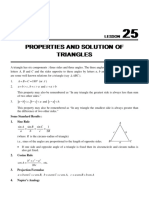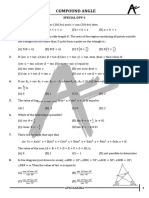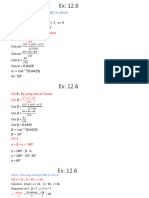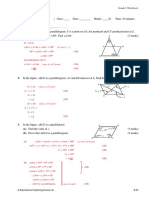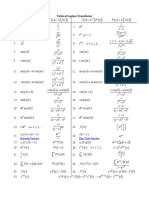BasicWS 5
Uploaded by
Jason YipBasicWS 5
Uploaded by
Jason Yip5 Quadrilaterals
Solutions (Basic)
5 Quadrilaterals 10. (a) ADC = ABC (opp. s of // gram)
3x = 2 x + 38
Basic Worksheet 5.2A
x = 38
1. (a) (b) ✓ (c) (d)
(e) ✓ (f) ✓ (g) (b) ABE = 2 x
= 2(38)
2. BC = AD (opp. sides of // gram) = 76
a=7 ABE + BED = 180 (int. s, AB // DC)
AB = DC (opp. sides of // gram) 76 + BED = 180
b=6 BED = 104
D = B 11. OC = OA (diags. of // gram)
3. (opp. s of // gram)
= 15 cm
c = 75
In △ABC,
C = A (opp. s of // gram) AB 2 = AC 2 + BC 2 (Pyth. theorem)
d = 105
AB = (15 + 15)2 + 162 cm
4. AO = CO (diags. of // gram) = 302 + 162 cm
e=8 = 34 cm
BO = DO (diags. of // gram)
12. ADC = ABC (opp. s of // gram)
f =5
= 70
i.e. CDE = 70
5. AD = BC (opp. sides of // gram)
In △CDE,
4−a = a
∵ DC = DE
4 = 2a ∴ DCE = DEC (base s, isos. △)
a=2 CDE + DEC + DCE = 180 ( sum of △)
70 + 2DEC = 180
6. D = B (opp. s of // gram)
2DEC = 110
2 x − 25 = x
DEC = 55
x = 25
BCE = DEC (alt.∠s, AD // BC)
= 55
7. ABC = ADC (opp. s of // gram)
24 + 2 y = 82
2 y = 58 Basic Worksheet 5.2B
y = 29
1. (a) Yes (Reason: opp. sides equal and //)
DO = BO (b) No
8. (diags. of // gram)
x+2=5 (c) No
x=3 (d) Yes (Reason: opp. s equal)
AO = CO (diags. of // gram) (e) No
2y − 3 = 3
2y = 6 2. ∵ DAC = (BCA)
y=3 ∴ AD // (BC) (alt. s equal)
∵ AD = (BC) and AD // (BC)
9. CD = AB (opp. sides of // gram) ∴ ABCD is a parallelogram. (opp. sides equal and //)
= 14 cm
AD = BC (opp. sides of // gram)
∵ Perimeter of parallelogram ABCD = 72 cm
∴ 2(14 cm + BC ) = 72 cm
14 cm + BC = 36 cm
BC = 22 cm
Junior Secondary Mathematics in Action 1 © Pearson Education Asia Limited 2022
5 Quadrilaterals
3. (a) Perimeter of quadrilateral PQRS = 28 cm 3. DO = BO (property of rhombus)
(2 x − 2) + 8 + ( x + 2) + (3 x − 4) = 28 x=6
6 x + 4 = 28 CO = AO (property of rhombus)
6 x = 24 = 5 cm
x=4 y = 5+5
= 10
(b) PQ = [2(4) − 2] cm = 6 cm
SR = (4 + 2) cm = 6 cm 4. CDO = ADO (property of rhombus)
PS = [3(4) − 4] cm = 8 cm 3x = 2 x + 23
∵ PQ = SR and QR = PS x = 23
∴ PQRS is a parallelogram. opp. sides equal
CBO = CDO (property of rhombus)
4. (a) In PQRS, y = 3(23)
104 + ( x + 38) + (3 x − 10) + 2 x = 360 = 69
( sum of polygon)
6 x + 132 = 360
5. DCO = BCO (property of rhombus)
6 x = 228
a = 66
x = 38
ADC + BCD = 180 (int. ∠s, AD // BC)
(b) Q = 38 + 38 = 76 b + (a + 66) = 180
R = 3(38) − 10 = 104 b + 66 + 66 = 180
S = 2(38) = 76 b = 48
∵ P = R and Q = S
∴ PQRS is a parallelogram. opp. s equal 6. BO = DO (property of rhombus)
5 x = x + 12
5. WK + KZ = XK + KY given
4 x = 12
8 cm + KZ = XK + 8 cm x=3
KZ = XK
AO = CO (property of rhombus)
∵ KZ = XK and WK = KY
∴ WXYZ is a parallelogram. diags. bisect each other x+ y=9
3+ y = 9
6. ∵ AB = AC given y=6
∴ ACB = ABC base ∠s, isos. △
= 48 7. AB = 30 cm
1
∵ ABC + BCD AO = AC (property of rhombus)
2
= 48 + (48 + 84)
1
= 180 = 36 cm
2
∴ AB // DC int. ∠s supp.
= 18 cm
∵ AB = DC and AB // DC
In △AOB,
∴ ABCD is a parallelogram. opp. sides equal and //
AOB = 90 (property of rhombus)
AO + BO = AB
2 2 2
(Pyth. theorem)
Basic Worksheet 5.3A BO = 30 − 18 cm2 2
1. BC = AD (definition of rhombus) = 24 cm
x = 15
CD = AD (definition of rhombus) 1
8. AO = AC (property of rhombus)
3 y = 15 2
1
y=5 = 24 cm
2
= 12 cm
2. AOB = 90 (property of rhombus) 1
x = 90 BO = BD (property of rhombus)
2
ABO = CBO (property of rhombus) 1
= 32 cm
y = 38 2
= 16 cm
Junior Secondary Mathematics in Action 2 © Pearson Education Asia Limited 2022
5 Quadrilaterals
6. OB = OD = OC = 17 cm (property of rectangle)
In △AOB, BCD = 90 (definition of rectangle)
AOB = 90 (property of rhombus) In △BCD,
AB 2 = AO 2 + BO 2 (Pyth. theorem) BC 2 + CD 2 = BD 2 (Pyth. theorem)
AB = 12 + 16 cm
2 2
CD = BD 2 − BC 2
= 20 cm
Perimeter of ABCD x = (17 + 17) 2 − 302
= 4 AB = 342 − 302
= 4(20) cm
= 16
= 80 cm
7. BF = AE (definition of rhombus)
= 13 cm
Basic Worksheet 5.3B
BD = 2 BF (property of rectangle)
1. DC = AB (property of rectangle) = 2 13 cm
x=9 = 26 cm
AD = BC (property of rectangle) In △BED,
BED = 90 (definition of rectangle)
y + 4 = 14
BE + DE = BD
2 2 2
(Pyth. theorem)
y = 10
BE = 26 − 24 cm
2 2
2. BAD = 90 (definition of rectangle) = 10 cm
x = 90
BCD = 90 (definition of rectangle) 8. In △ABC,
In △BCD, ABC = 90 (definition of rectangle)
BCD + CBD + BDC = 180 (∠ sum of ) AC 2 = AB 2 + BC 2 (Pyth. theorem)
90 + 36 + y = 180 AC = 122 + 352 cm
y = 54 = 37 cm
1
AF = AC (property of rectangle)
3. DO = BO (property of rectangle) 2
2x = 8 1
= 37 cm
x=4 2
AC = BD (property of rectangle) = 18.5 cm
AE = AF (definition of rhombus)
y = 2(4) + 8
= 18.5 cm
= 16
4. CO = BO (property of rectangle) Basic Worksheet 5.3C
4 p = 16
1. AB = CD (definition of square)
p=4
x = 12
BO = CO
OBC = OCB (base ∠s, isos. △) BC = CD (definition of square)
q = 31 3 y = 12
y=4
5. ∵ OA = OD (property of rectangle)
2. AOB = 90 (property of square)
∴ OAD = ODA (base ∠s, isos. △)
x = 90
= 36
In △AOD, ACB = 45 (property of square)
AOB = OAD + ODA (ext. ∠ of ) y = 45
x = 36 + 36
= 72 3. OB = OD (property of square)
ADC = 90 (definition of rectangle) x = 20
In △ADC, OC = OD (property of square)
ACD + CAD + ADC = 180 (∠ sum of ) 4 y = 20
y + 36 + 90 = 180 y=5
y = 54
Junior Secondary Mathematics in Action 3 © Pearson Education Asia Limited 2022
5 Quadrilaterals
8. (a) ∵ OA = OC (property of square)
1
4. BCD = 45 (property of square) ∴ OA = AC
2
n + 20 = 45 1
= 30 cm
n = 25 2
ABE = 90 (definition of square) = 15 cm
In △ABE, ∴ OB = OA (property of square)
ABE + AEB + BAE = 180 (∠ sum of ) = 15 cm
90 + 60 + m = 180
m = 30 (b) In △AOB,
AOB = 90 (property of square)
5. ADB = 45 (property of square) AB = OA + OB
2 2 2
(Pyth. theorem)
In △BDE, AB = 15 + 15 cm
2 2
DBE + BED = ADB (ext. ∠ of )
= 450 cm
y + 28 = 45
Perimeter of square ABCD
y = 17 = 4 AB
BDF = 45 (property of square) = 4 450 cm
In △BDF, = 84.9 cm (cor. to 3 sig. fig.)
BFC = DBF + BDF (ext. ∠ of )
x = 17 + 45
= 62 Basic Worksheet 5.4
1. ∵ AD = BC property of rectangle
6. BAE = 45 (property of square) ∴ AE = AD − DE
In △ABE, = BC − BF
∵ AE = AB = CF
∴ AEB = ABE (base ∠s, isos. △)
BAE + ABE + AEB = 180 (∠ sum of ) 2. ∵ ABC = ADC property of rhombus
45 + 2ABE = 180 ∴ ABE = ABC − EBC
ABE = 67.5 = ADC − EDC
ABC = 90 (definition of square) = ADE
x = ABC − ABE
= 90 − 67.5 3. PQX = RSY opp. ∠s of // gram
= 22.5
PXR = QPX + PQX ext. of △
= SRY + RSY
BEC + AEB = 180 (adj. s on st. line)
= RYP
y + 67.5 = 180 ext. of △
y = 112.5
4. ABC = ADC opp. ∠s of // gram
7. AD = AB = 10 cm (definition of square) =y
In △ABD, In △ABE,
BAD = 90 (definition of square) ∵ AB = AE given
BD = AB + AD
2 2 2
(Pyth. theorem) ∴ AEB = ABE base ∠s, isos. △
BD = 10 + 10 cm
2 2
=y
= 200 cm AEC + AEB = 180 adj.∠s on st. line
∵ OD = OB (property of square) x + y = 180
1
∴ OD = BD
2 5. In △QPX and △SRY,
200 PQ = RS definition of square
= cm
2 PQX = RSY = 45 property of square
= 7.07 cm (cor. to 3 sig. fig.) QY = XS given
QX + XY = XY + SY
QX = SY
∴ △QPX △SRY SAS
Junior Secondary Mathematics in Action 4 © Pearson Education Asia Limited 2022
5 Quadrilaterals
6. (a) In △ABE and △ADF, 4. AE = (12 – 6) cm = 6 cm
BAE = DAF given In △ABC,
AB = AD definition of rhombus ∵ AD = DB and AE = EC
ABE = ADF property of rhombus ∴ DE // BC (mid-pt. theorem)
∴ △ABE △ADF ASA ∴ ADE = ABC (corr. s, DE // BC)
3 y = 57
(b) ∵ △ABE △ADF proved in (a)
y = 19
∴ BE = DF corr. sides, △s
∵ BC = CD 1
definition of rhombus DE = BC (mid-pt. theorem)
∴ CE = BC − BE 2
= CD − DF 1
x= 8
= CF 2
=4
7. (a) In △ABE and △CBF,
BAE = BCF = 90 definition of square 5. In △ABC,
BE = BF given ∵ AD = DB and AE = EC (given)
AB = CB definition of square ∴ DE // BC (mid-pt. theorem)
∴ △ABE △CBF RHS ∴ ADE = ABC (corr. s, DE // BC)
= 75
(b) ∵ △ABE △CBF proved in (a)
In △ADE,
∴ AE = CF corr. sides, △s
ADE + DAE + AED = 180 (∠ sum of )
∵ AD = CD definition of square
75 + 43 + y = 180
∴ DE = AD − AE
y = 62
= CD − CF
= DF
∴ △DEF is an isosceles 6. In △ACD,
triangle. ∵ AB = BC and AG = GD (given)
1
∴ BG = CD (mid-pt. theorem)
2
Basic Worksheet 5.5A 1
4 = ( y + 5)
1. In △ABC, 2
∵ AD = DB and AE = EC (given) 8= y+5
1 y=3
∴ DE = BC (mid-pt. theorem)
2 In △ADE,
1 ∵ AG = GD and AF = FE
a = 4
2 ∴ GF // DE (mid-pt. theorem)
=2 ∴ AFG = AED (corr. s, GF // DE)
= 3x
2. In △ABC, In △AGF,
∵ AD = DB and AE = EC (given) AGF + GAF + AFG = 180 (∠ sum of )
1
∴ DE = BC (mid-pt. theorem) 60 + 2 x + 3x = 180
2 5 x = 120
1
3= k x = 24
2
k =6
7. (a) In △ADG,
∵ DB = (3 + 3) cm = 6 cm = BA and
3. In △ABC,
DF = (2 + 2) cm = 4 cm = FG
∵ AD = DB and AE = EC (given)
1
∴ DE // BC (mid-pt. theorem) ∴ BF = AG (mid-pt. theorem)
2
∴ AED = ACB (corr. s, DE // BC ) 1
c = 56 = 18 cm
2
= 9 cm
Junior Secondary Mathematics in Action 5 © Pearson Education Asia Limited 2022
5 Quadrilaterals
(b) In △BDF,
∵ DC = CB and DE = EF (given) Basic Worksheet 5.5B
∴ CE = 1 BF (mid-pt. theorem) 1. ∵ AB // CD // EF and CE = AC
2 ∴ DF = BD (intercept theorem)
1
= 9 cm x=6
2
= 4.5 cm
2. In △ADE,
∵ AB = BD and BC // DE
8. (a) In △ACD, ∴ AC = CE (intercept theorem)
∵ DF = FC and AG = GC (given) x=5
1
∴ GF = AD (mid-pt. theorem)
2
3. ∵ AB // CD // EF and AC = CE
1
= 20 cm ∴ BD = DF (intercept theorem)
2
h=k
= 10 cm
∵ BD + DF = 18 cm
h + k = 18
(b) EG = EF − GF
2h = 18
= (26 − 10) cm
h=9
= 16 cm
In △ABC, ∴ k =h=9
∵ AE = EB and AG = GC (given)
1 In △QZY,
∴ EG = BC (mid-pt. theorem) 4.
2 ∵ XZ = QX and XW // ZY
1 ∴ YW = QW (intercept theorem)
16 cm = BC
2 p = 3.5
BC = 32 cm
∵ XW // ZY // RP and ZR = XZ
∴ PY = YW (intercept theorem)
9. (a) In △ACE,
q = 3.5
∵ AB = BC and AF = FE given
1
∴ BF = CE mid-pt. theorem
2 5. In △ACD,
= DE ∵ BE // CD and AB = BC
∵ AB = BC and CD = DE given ∴ AE = ED (intercept theorem)
1 ∵ AB = BC and AE = ED
∴ BD = AE mid-pt. theorem
1
2 ∴ BE = CD (mid-pt. theorem)
= EF 2
∵ BF = DE and BD = EF 1
x = 6
∴ BDEF is a parallelogram. opp. sides equal 2
=3
Alternative Solution
In △ACE,
6. In △ABC,
∵ AB = BC and AF = FE given ∵ EF // BC and EB = AE
∴ BF // DE mid-pt. theorem
∴ FC = AF (intercept theorem)
∵ AB = BC and CD = DE given
∴ BD // EF mid-pt. theorem a =8
∵ BF // DE and BD // EF In △ACD,
∴ BDEF is a parallelogram. ∵ FG // CD and AF = FC
∴ AG = GD (intercept theorem)
(b) In △ACE, ∵ AF = FC and AG = GD
ACE + AEC + CAE = 180 (∠ sum of ) 1
∴ FG = CD (mid-pt. theorem)
73 + AEC + 52 = 180 2
AEC = 55 1
7 = (b − 2)
DBF = AEC (opp. s of // gram) 2
= 55 14 = b − 2
b = 16
Junior Secondary Mathematics in Action 6 © Pearson Education Asia Limited 2022
5 Quadrilaterals
7. (a) In △ABC,
∵ EG // BC and AE = EB
∴ AG = GC (intercept theorem)
∵ AE = EB and AG = GC
1
∴ EG = 2 BC (mid-pt. theorem)
1
= 18 cm
2
= 9 cm
(b) In △ACD,
∵ AD // GF and AG = GC
∴ CF = FD (intercept theorem)
∵ AG = GC and CF = FD
1
∴ GF = AD (mid-pt. theorem)
2
1
= 10 cm
2
= 5 cm
EF = EG + GF
= (9 + 5) cm
= 14 cm
8. (a) In △BCD,
∵ GF // BC and CF = FD
∴ BG = GD (intercept theorem)
∵ CF = FD and BG = GD
1
∴ GF = 2 BC (mid-pt. theorem)
1
= 16 cm
2
= 8 cm
(b) EG = EF − GF
= (20 − 8) cm
= 12 cm
In △ABD,
∵ AD // EG and BG = GD
∴ AE = EB (intercept theorem)
∵ BG = GD and AE = EB
1
∴ EG = AD (mid-pt. theorem)
2
1
12 cm = AD
2
AD = 24 cm
Junior Secondary Mathematics in Action 7 © Pearson Education Asia Limited 2022
You might also like
- Kleppner An Introduction To Mechanics 2ed Solutions PDF100% (3)Kleppner An Introduction To Mechanics 2ed Solutions PDF216 pages
- 2nd Departmental Mock Exam (Mathematics) Answer KeyNo ratings yet2nd Departmental Mock Exam (Mathematics) Answer Key3 pages
- Board of Intermediate & Secondary Education, Lahore ResultsNo ratings yetBoard of Intermediate & Secondary Education, Lahore Results1 page
- More About Basic Properties of Circles: Oa Ob Ox OxNo ratings yetMore About Basic Properties of Circles: Oa Ob Ox Ox55 pages
- Junior Secondary Mathematics in Action 3A - Chapter 06 Special Lines and Centres in A Triangle - Full SolutionsNo ratings yetJunior Secondary Mathematics in Action 3A - Chapter 06 Special Lines and Centres in A Triangle - Full Solutions27 pages
- Question 16B and 16C of Extension 2 Maths HSC Exam50% (2)Question 16B and 16C of Extension 2 Maths HSC Exam5 pages
- S1 2ndterm Common Mistake Activity PreEx - SolNo ratings yetS1 2ndterm Common Mistake Activity PreEx - Sol6 pages
- Math Mission -Day-5 Sample Paper-4-Ans KeyNo ratings yetMath Mission -Day-5 Sample Paper-4-Ans Key11 pages
- MATH MISSION -DAY-3 SAMPLE PAPER-2-ANS KEYNo ratings yetMATH MISSION -DAY-3 SAMPLE PAPER-2-ANS KEY7 pages
- Motion in Plane NEET JEE Practice QuestiosNo ratings yetMotion in Plane NEET JEE Practice Questios174 pages
- All India Medical NEET & Engineering JEE Main Entrance Examination (1) Split PDF 1717680211889No ratings yetAll India Medical NEET & Engineering JEE Main Entrance Examination (1) Split PDF 171768021188912 pages
- 01 (02) - Vector - Solved Example Module-6-ANo ratings yet01 (02) - Vector - Solved Example Module-6-A10 pages
- 25 - Properties and Solution of TrianglesNo ratings yet25 - Properties and Solution of Triangles38 pages
- (11-16) 2B-Ch.9-Introduction to Deductive Geometry - ANSNo ratings yet(11-16) 2B-Ch.9-Introduction to Deductive Geometry - ANS3 pages
- 81261_UA-010_Solution of triangles_Lecture NotesNo ratings yet81261_UA-010_Solution of triangles_Lecture Notes60 pages
- S1 W37 R09 Congruent-And-Similar-Triangle Ver2023 Homework SolutionNo ratings yetS1 W37 R09 Congruent-And-Similar-Triangle Ver2023 Homework Solution5 pages
- Sine Rule, Cosine Rule and Area of Triangle WS Answer-RevisionNo ratings yetSine Rule, Cosine Rule and Area of Triangle WS Answer-Revision6 pages
- Solve Following Triangle ABC in Which: Q1 A 7, B 7, C 9No ratings yetSolve Following Triangle ABC in Which: Q1 A 7, B 7, C 924 pages
- DPP 04 Video Solution Sequence & Progression NJ 247No ratings yetDPP 04 Video Solution Sequence & Progression NJ 2475 pages
- Junior Secondary Mathematics in Action 1B - Chapter 11 Angles Related To Lines - Full Solutions100% (1)Junior Secondary Mathematics in Action 1B - Chapter 11 Angles Related To Lines - Full Solutions17 pages
- 02. G8 Math Geometry FinalModel Al.adwaa Answers T1 2025No ratings yet02. G8 Math Geometry FinalModel Al.adwaa Answers T1 202510 pages
- Section Quiz 8.1: CE AE (Diags. of // Gram)No ratings yetSection Quiz 8.1: CE AE (Diags. of // Gram)4 pages
- Trigonometric Ratios of Acute Angles - Finding Unknown Lengths & AnglesNo ratings yetTrigonometric Ratios of Acute Angles - Finding Unknown Lengths & Angles6 pages
- Analytic Geometry: Graphic Solutions Using Matlab LanguageFrom EverandAnalytic Geometry: Graphic Solutions Using Matlab LanguageNo ratings yet
- 10+2 Level Mathematics For All Exams GMAT, GRE, CAT, SAT, ACT, IIT JEE, WBJEE, ISI, CMI, RMO, INMO, KVPY Etc.From Everand10+2 Level Mathematics For All Exams GMAT, GRE, CAT, SAT, ACT, IIT JEE, WBJEE, ISI, CMI, RMO, INMO, KVPY Etc.No ratings yet
- MATHEMATICS Compulsory Part Paper 2: JtehtNo ratings yetMATHEMATICS Compulsory Part Paper 2: Jteht15 pages
- 21 Hkcee Math 2010 Paper 1 Solution Only 1No ratings yet21 Hkcee Math 2010 Paper 1 Solution Only 17 pages
- Final Examination Schedule 2021-2022: (Student Version)No ratings yetFinal Examination Schedule 2021-2022: (Student Version)2 pages
- Position Paper: How Good Is Part-Time Work?No ratings yetPosition Paper: How Good Is Part-Time Work?7 pages
- Class Association 1st Kahoot Competition QuestionsNo ratings yetClass Association 1st Kahoot Competition Questions11 pages
- Class Association 1st Kahoot Competition Questions-1No ratings yetClass Association 1st Kahoot Competition Questions-114 pages
- Second Quarter General Performance in English For Sy 2022 by Grade LevelNo ratings yetSecond Quarter General Performance in English For Sy 2022 by Grade Level40 pages
- Grade 7, IMO Demo Test: Two Consecutive MonthsNo ratings yetGrade 7, IMO Demo Test: Two Consecutive Months10 pages
- First HPTA Meeting Attendance With AgendaNo ratings yetFirst HPTA Meeting Attendance With Agenda4 pages
- Kleppner An Introduction To Mechanics 2ed Solutions PDFKleppner An Introduction To Mechanics 2ed Solutions PDF
- 2nd Departmental Mock Exam (Mathematics) Answer Key2nd Departmental Mock Exam (Mathematics) Answer Key
- Board of Intermediate & Secondary Education, Lahore ResultsBoard of Intermediate & Secondary Education, Lahore Results
- More About Basic Properties of Circles: Oa Ob Ox OxMore About Basic Properties of Circles: Oa Ob Ox Ox
- Junior Secondary Mathematics in Action 3A - Chapter 06 Special Lines and Centres in A Triangle - Full SolutionsJunior Secondary Mathematics in Action 3A - Chapter 06 Special Lines and Centres in A Triangle - Full Solutions
- Question 16B and 16C of Extension 2 Maths HSC ExamQuestion 16B and 16C of Extension 2 Maths HSC Exam
- All India Medical NEET & Engineering JEE Main Entrance Examination (1) Split PDF 1717680211889All India Medical NEET & Engineering JEE Main Entrance Examination (1) Split PDF 1717680211889
- (11-16) 2B-Ch.9-Introduction to Deductive Geometry - ANS(11-16) 2B-Ch.9-Introduction to Deductive Geometry - ANS
- S1 W37 R09 Congruent-And-Similar-Triangle Ver2023 Homework SolutionS1 W37 R09 Congruent-And-Similar-Triangle Ver2023 Homework Solution
- Sine Rule, Cosine Rule and Area of Triangle WS Answer-RevisionSine Rule, Cosine Rule and Area of Triangle WS Answer-Revision
- Solve Following Triangle ABC in Which: Q1 A 7, B 7, C 9Solve Following Triangle ABC in Which: Q1 A 7, B 7, C 9
- DPP 04 Video Solution Sequence & Progression NJ 247DPP 04 Video Solution Sequence & Progression NJ 247
- Junior Secondary Mathematics in Action 1B - Chapter 11 Angles Related To Lines - Full SolutionsJunior Secondary Mathematics in Action 1B - Chapter 11 Angles Related To Lines - Full Solutions
- 02. G8 Math Geometry FinalModel Al.adwaa Answers T1 202502. G8 Math Geometry FinalModel Al.adwaa Answers T1 2025
- Trigonometric Ratios of Acute Angles - Finding Unknown Lengths & AnglesTrigonometric Ratios of Acute Angles - Finding Unknown Lengths & Angles
- Analytic Geometry: Graphic Solutions Using Matlab LanguageFrom EverandAnalytic Geometry: Graphic Solutions Using Matlab Language
- 10+2 Level Mathematics For All Exams GMAT, GRE, CAT, SAT, ACT, IIT JEE, WBJEE, ISI, CMI, RMO, INMO, KVPY Etc.From Everand10+2 Level Mathematics For All Exams GMAT, GRE, CAT, SAT, ACT, IIT JEE, WBJEE, ISI, CMI, RMO, INMO, KVPY Etc.
- Final Examination Schedule 2021-2022: (Student Version)Final Examination Schedule 2021-2022: (Student Version)
- Class Association 1st Kahoot Competition QuestionsClass Association 1st Kahoot Competition Questions
- Class Association 1st Kahoot Competition Questions-1Class Association 1st Kahoot Competition Questions-1
- Second Quarter General Performance in English For Sy 2022 by Grade LevelSecond Quarter General Performance in English For Sy 2022 by Grade Level
































